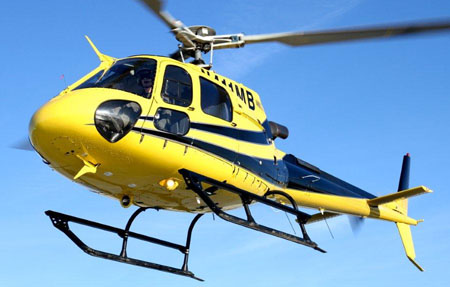Helicopter Turbine Transition Courses
Most beginner students at HeliStream learn to fly in a Robinson R22 or R44. These Robinson models are perfect for learning the basics of flying a helicopter. However, in order to become a more diverse, commercially marketable pilot, students may opt to train in turbine helicopters. In order to help student pilots transition from Robinson flight techniques to turbine helicopters, HeliStream has developed an intensive helicopter turbine transition course.
HeliStream developed a training course specifically for helicopter turbine transitioning because our experience has taught us that pilots with turbine experience are often the first hired. HeliStream’s helicopter turbine transition training helps pilots advance their careers and meet industry standards in today’s competitive job market.

FAQ's
A: On the ground, our turbine transition training course includes a thorough introduction to preflight procedures, aircraft limitations and emergency procedures specific to the appropriate turbine make and model.
In the air, the student will begin by performing normal operating procedures. Abnormal and emergency procedures will be demonstrated and practiced until the pilot develops increased confidence in his ability to safely maneuver the aircraft. Completion standards will be determined by the Practical Test Standards specific to the pilot certificate held.
Q: What is the History of Turbine Transition Training
The first turbo shaft helicopter engine was developed in the early 1950s. From this point, jet engine and turbine technology continued to revolutionize the design and capabilities of helicopters. Engineers discovered that a turbine engine produced a more powerful helicopter that weighed less than those with piston engines.
Q: What’s the difference between a Reciprocating Helicopter and a Turbine Helicopter?
A: Quite simply the power plant. The R22 and R44 are powered by a piston engine and the turbine helicopter is powered by a sophisticated turbo shaft engine. The most significant differences are found in the power to weight ratio. For example, most piston engines will weigh twice as much as the power they can produce whereas a turbine engine only weighs about 25% of the horse power produced. This translates to more payload and better high altitude performance, which is why most commercial operations are performed using turbine helicopters.
Turbine-powered helicopters have more power and flexibility due to their advanced, light-weight engines. Turbine helicopters can fly at higher altitudes and higher temperatures. In short, they can go where Robinson helicopters cannot.
Over the years Helistream’s original helicopter turbine transition training course has developed into the leading turbine training program in California. We have also added several turbine training helicopters to our fleet.
Our staff of experienced instructors, skilled at both piston and turbine flight techniques, can help you expand your flight skills to include any helicopter model. We can also help you transition laterally, from one advanced helicopter to another. Our transition program includes numerous advanced helicopters so that you can build on your skills even beyond the turbine if that is your desire.
Courses and Requirements
*Robinson R44 Transition
*AS350 Turbine Transition
Course Requirements
- Hold a private pilot helicopter certificate.
- Obtain sufficient dual instruction for proficiency.
- Demonstrate knowledge and ability of pilot certificate helicopter operations in a Robinson R44.
Course Includes
- 5 hours of dual instruction
- 12 hours of ground instruction
Course Requirements
- Hold a private pilot helicopter certificate.
- Obtain sufficient dual instruction for proficiency.
- Demonstrate knowledge and ability of pilot certificate helicopter operations in an AS350.
Course Includes
- 5 hours of dual instruction
- 12 hours of ground instruction
*MD500 Turbine Transition
*MD530 Turbine Transition
Course Requirements
- Hold a private pilot helicopter certificate.
- Obtain sufficient dual instruction for proficiency.
- Demonstrate knowledge and ability of pilot certificate helicopter operations in a MD500.
Course Includes
- 5 hours of dual instruction
- 12 hours of ground instruction
Course Requirements
- Hold a private pilot helicopter certificate.
- Obtain sufficient dual instruction for proficiency.
- Demonstrate knowledge and ability of pilot certificate helicopter operations in a MD530.
Course Includes
- 5 hours of dual instruction
- 12 hours of ground instruction
Course Includes
*EC-120 Turbine Transition
*Bell 205 Turbine Transition
Course Requirements
- Hold a private pilot helicopter certificate.
- Obtain sufficient dual instruction for proficiency.
- Demonstrate knowledge and ability of pilot certificate helicopter operations in an EC-120.
Course Includes
- 5 hours of dual instruction
- 12 hours of ground instruction
Course Requirements
- Hold a private pilot helicopter certificate.
- Obtain sufficient dual instruction for proficiency.
- Demonstrate knowledge and ability of pilot certificate helicopter operations in a Bell 205.
Course Includes
- 5 hours of dual instruction
- 12 hours of ground instruction
*Please note that all Transition Courses can take from 5-10 hours of flight time depending on ability and proficiency.
Contact Us
John Wayne Airport
3000 Airway Ave
Suite 350
Costa Mesa, CA 92626 USA
PH: (714) 662-3163
Email Us


